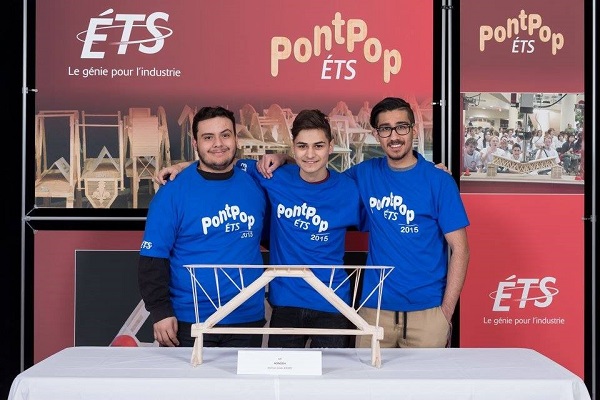MY KINGDOM FOR A POPSICLE STICK
For a long time, I have been fascinated by the beauty of engineering. Science has gotten us a great distance and given us many useful concepts to play with, but without actually putting those concepts to us––without knowing how to apply them to their fullest potential––we wouldn’t have gotten very far as a civilization.
 Exploring the potential uses of even the simplest of materials can lead to some pretty incredible results. A perfect example of this is the popsicle bridge building competition every year at University of Quebec’s ETS campus. The premise is simple: small model bridges, roughly a meter long, made entirely out of popsicle sticks, toothpicks, dental floss and white glue, are crushed by a hydraulic press and then evaluated based on their aesthetics and weight efficiency. Popsicle sticks by themselves can be broken with fingers and white glue rapidly dissolves when exposed to water, and it’s a rather messy combination to work with as a whole, leaving black drops of glue mixed with dust everywhere as you work.
Exploring the potential uses of even the simplest of materials can lead to some pretty incredible results. A perfect example of this is the popsicle bridge building competition every year at University of Quebec’s ETS campus. The premise is simple: small model bridges, roughly a meter long, made entirely out of popsicle sticks, toothpicks, dental floss and white glue, are crushed by a hydraulic press and then evaluated based on their aesthetics and weight efficiency. Popsicle sticks by themselves can be broken with fingers and white glue rapidly dissolves when exposed to water, and it’s a rather messy combination to work with as a whole, leaving black drops of glue mixed with dust everywhere as you work.
And yet… I was utterly impressed by the practical skills and ingenuity of simple high school students when I participated in the competition in 2015. The bridges I saw looked for the most part even more elegant and well-built than most bridges in real life, and some could withstand many times the weight of a small car when placed under the press. Some teams had spent the time to glue sticks into large blocks of wood out of which they then carved out the components of their bridges, so they ended up with round surfaces, cylindrical wooden support beams, triangular trusses and many more fascinating structures. The winning bridges all shared the same design, which is that of a trapezoidal truss, which happens to be by far the simplest and most efficient design given the circumstances, but despite the design similarities, each bridge was unique in its own right. It’s worth mentioning that they had lots of help from their teachers, but it still seems unreal that high school students built these marvels, and with nothing but the simplest of materials––and the knowledge of how to apply engineering principles.
My bridge was designed to withstand the highest press charge possible while disregarding height, and with the proven sturdy design and the fact that it was in an entirely different weight category compared to all the previous winning bridges, it should have easily taken the victory. Unfortunately, I didn't have the experience in handling wood that the other school's teachers had, and I didn't foresee one fatal flaw, or glitch if you will, which seemed trivial but ended up costing me the prize. I did end up in the top 10 and set a new record for my school which still stands, but the design was meant to take 2-3 times that weight, so I was left very disappointed and am still mad at myself despite 2 years passing since I first embarked on that project.
With the new rules, my old bridge is no longer viable (it was left mostly intact after its baptism by metaphorical fire)... This is why I want to give it another shot this year and hopefully beat the all time 4600kg record which my first bridge was meant to break. (Mind you, that record is from 2006, when the rules were far less strict and allowed for much tougher bridges overall.) I'm confident I can do it if I just improve on my old design a little and make it fit the new rules.
Below is the event's official stream and the part where my bridge appeared. Attached are also pictures of insane bridge designs, namely from Dorval Jean XXIII Highschool, which is known for being by far the most serious player in the game and usually has the best bridges.
https://www.youtube.com/watch?v=MEZmq8sQzd4
Photos from:
https://www.facebook.com/pontpop/photos/?tab=album&album_id=923743587649345

Comments
No comments posted yet.
You have to be registered and logged in in order to post comments!